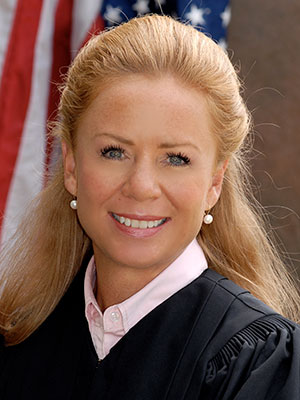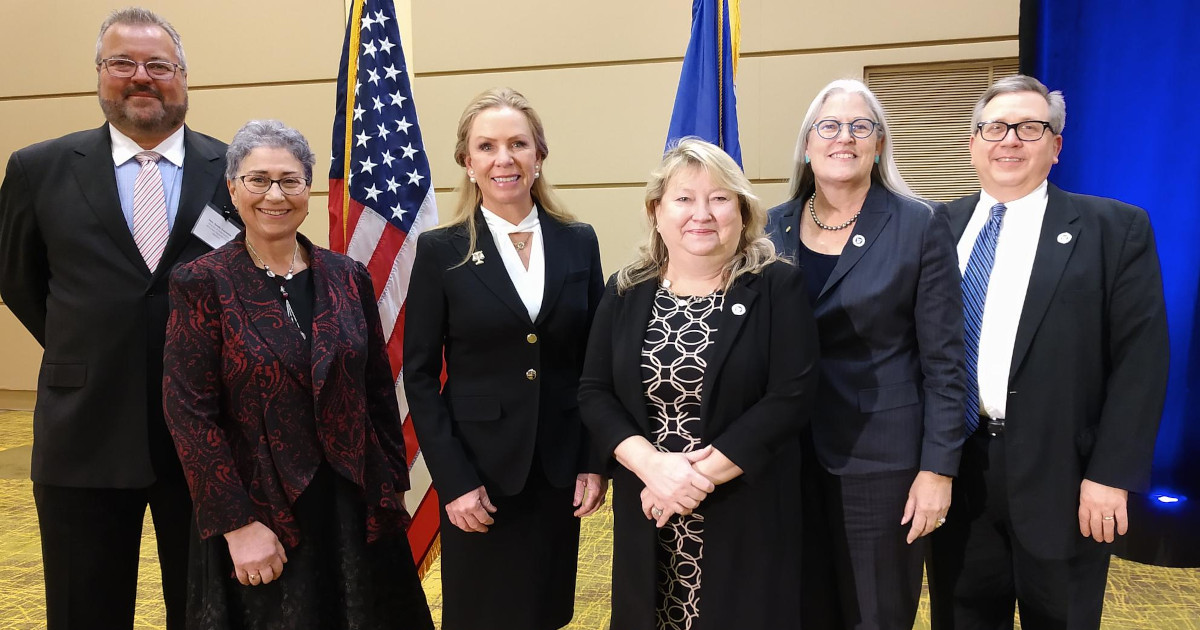
Nov. 4, 2021 – During her State of the Judiciary yesterday (Nov. 3), Wisconsin Supreme Court Chief Justice Annette Ziegler said the state’s justice system will build upon innovations forced by the pandemic to become more efficient.
“Ultimately, people got creative and found new ways to get the work accomplished,” Chief Justice Ziegler said during the address at the 2021 Annual Meeting of the Wisconsin Judicial Conference. “The last year-and-a-half may not have felt like a success as it unfolded. But when you look at in terms of how people responded, and what we’ve accomplished, it definitely was a success.”
Judges were among the most creative, Ziegler said in her first address since becoming chief justice last April, succeeding former Chief Justice Patience Roggensack.
Chief Justice Ziegler said the pandemic forced many of them to take on roles outside the traditional job description for a jurist.
For instance, some judges had to act as real estate brokers, working out deals for additional space for juries and courtrooms. Others took on the duties of project managers, to help ensure that construction and remodeling projects would meet new court-system needs necessitated by the pandemic.
Many also worked as logistics analysts, pushing cases along as the pandemic forced profound disruptions in judicial procedures and proceedings.
“Many of you have taken on new challenges, and your extraordinary work has helped keep our courts operational,” Chief Justice Ziegler said. “In fact, all of our courts are back to holding in-person appearances and jury trials. That is a success story.”
Role of Zoom
Use of the Zoom videoconferencing platform to enable parties to appear virtually drove much of the innovation, Chief Justice Ziegler said.
For instance, the early adoption of Zoom by Judge Ann Knox-Bauer in District Nine, one of three northern judicial districts, helped cut down on the rate of failures to appear.
“People who otherwise may not be able to make a court appearance for any one of a number of reasons may be able to do so via Zoom, sometimes saving the need for time off work or childcare,” the chief justice said. “This is true in more populous counties as well.”
To prove that point, Chief Justice Ziegler cited a case from La Crosse County, where Zoom was the catalyst for the resolution of a divorce case that had been stalled for several years.
The petitioner, who worked on a construction crew, was unable to locate her husband. During a status hearing held via Zoom, the woman said her husband was in jail. The court called the phone number that the woman’s husband had given the jail when he was released.
That call led to information that the man was jailed in another county. Cooperation from that county and the woman’s construction supervisor allowed Judge Ramona Gonzalez to grant the couple a divorce later on the same day, the chief justice said.

The 2021 Annual Meeting of the Wisconsin Judicial Conference. From left: Director of State Courts, Judge Randy Koschnick; State Bar of Wisconsin President Cheryl Daniels; Wisconsin Supreme Court Chief Justice Annette Ziegler; Immediate Past State Bar President Kathy Brost; State Bar President-elect Margaret Hickey; and State Bar Executive Director Larry J. Martin.
Zoom has enabled other efficiencies, she noted. Judges use the app to avoid having to make long trips to multiple courthouses in a single day. It also allows lawyers to appear remotely on behalf of criminal defendants in rural counties suffering from a shortage of defense lawyers.
“This has not only improved access to legal representation, but has also helped keep cases moving,” Chief Justice Ziegler said. “Zoom has also proven to be a better option than some of our older videoconferencing equipment to handle appearances from jail.”
Ziegler said the judiciary was also working to help parties who don’t have electronic devices or reliable internet service use Zoom. For instance, the Children’s Court Improvement Program is using federal grant money to create remote access spaces.
“Zoom will not be appropriate for every proceeding, but it has made a huge difference during the pandemic and will remain a useful tool,” Chief Justice Ziegler said.
Ziegler thanked the state’s judges for their adaptability during the pandemic.
“The work of a judge and the role of the courts are too important to put off, and your willingness to adjust has helped us avoid potentially larger backlogs. We are way ahead of where we would be otherwise.”
eFiling and Other Innovations
Chief Justice Ziegler said Wisconsin’s judicial system was well prepared for the changes forced by the pandemic because the circuit courts had a good electronic filing system in place pre-pandemic.
The court of appeals made mandatory electronic filing on July 1, 2020. The supreme court is next, Ziegler said.
“We have two cases that are proceeding as part of an eFiling pilot project, and we have the rules and framework in place to move ahead when the time is right.”
Ziegler also hailed non-technological innovations designed to make the court system work better.
In January, Waukesha County will reallocate one judge from the family division to the criminal traffic division for two years, in an effort to clear a backlog of criminal cases.
The move is funded with federal American Rescue Plan Act money and is the result of a collaboration between Chief Judge Jennifer Dorow and the county executive, county administrators, the district attorney, the sheriff, and the clerk of courts.
“This plan also would not have been possible without the opening of Waukesha County’s new secure courthouse addition, which provides seven courtrooms and an intake courtroom with direct access to the jail and inmate holding,” Ziegler said.
Then there was the juggling act that Milwaukee County Circuit Court Chief Judge Mary Triggiano had to perform when the pandemic hit Milwaukee. Triggiano was a month into her job on March 14, 2020 when the spread of the coronavirus forced her to cancel court proceedings in 47 circuit court branches.
“Chief Judge Triggiano updated administrative orders and directives in line with Supreme Court orders,” the chief justice said. “She made virtual media appearances along with other justice system partners, including prosecutors, defense attorneys, and county officials. She kept the legal community and the public informed and let everyone know that everyone was working together to ensure what could be done, was being done.”
At the close of her speech, Chief Justice Ziegler thanked her predecessor, former Chief Justice Roggensack, for her leadership.
“Without her direction, we’d be in a more difficult situation overall,” Ziegler said. “Early on in the pandemic, she convened the Wisconsin Court System’s COVID-19 Task Force. The Task Force Report, which included recommendations for precautions to be taken during the pandemic, served as guidepost for courts statewide – and still does.”
